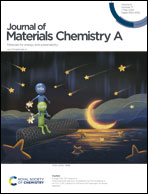Testing the predictive power of theory for PdxIr(100−x) alloy nanoparticles for the oxygen reduction reaction†
Abstract
In this report, density functional theory (DFT) calculations of O and OH binding energies on triatomic surface ensembles of PdxIr(100−x) nanoalloys successfully predicted the overall trend in experimental oxygen reduction reaction (ORR) activity as a function of nanoparticle (NP) composition. Specifically, triatomic Pd3 ensembles were found to possess optimal O and OH binding energies and were predicted to be highly active sites for the ORR, rivaling that of Pt(111). However, DFT calculations suggest that the O binding energy increases at active sites containing Ir, thereby decreasing ORR activity. PdxIr(100−x) nanoalloys were synthesized using a microwave-assisted method and their activity towards the ORR was tested using rotating disk voltammetry (RDV). As predicted, the bimetallic electrocatalysts exhibited worse catalytic activity than the Pd-only NPs. The strong qualitative correlation between the theoretical and experimental results demonstrates that the activity of individual active sites on the surface of NPs can serve as a proxy for overall activity. This is a particularly useful strategy for applying DFT calculations to electrocatalysts that are too large for true first-principle analysis.



 Please wait while we load your content...
Please wait while we load your content...
